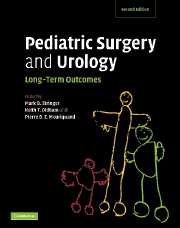Book contents
- Frontmatter
- Contents
- List of contributors
- Acknowledgments
- Preface
- Part I General issues
- Part II Head and neck
- 6 Cleft lip and palate
- 7 Lymphangiomas
- 8 Thyroid and parathyroid (including thyroglossal disorders)
- 9 Salivary glands disorders
- 10 Head and neck tumors
- Part III Thorax
- Part IV Abdomen
- Part V Urology
- Part VI Oncology
- Part VII Transplantation
- Part VIII Trauma
- Part IX Miscellaneous
- Index
- Plate section
- References
9 - Salivary glands disorders
from Part II - Head and neck
Published online by Cambridge University Press: 08 January 2010
- Frontmatter
- Contents
- List of contributors
- Acknowledgments
- Preface
- Part I General issues
- Part II Head and neck
- 6 Cleft lip and palate
- 7 Lymphangiomas
- 8 Thyroid and parathyroid (including thyroglossal disorders)
- 9 Salivary glands disorders
- 10 Head and neck tumors
- Part III Thorax
- Part IV Abdomen
- Part V Urology
- Part VI Oncology
- Part VII Transplantation
- Part VIII Trauma
- Part IX Miscellaneous
- Index
- Plate section
- References
Summary
Introduction
With the exception of mumps, salivary gland disease is relatively uncommon in childhood. However, the range of conditions that can occur are the same as in the adult population, although the relative incidence is very different.
Careful history-taking and detailed examination are critical. Details of onset, duration, periodicity, size, and location of any swelling and the character of any salivary secretions must be recorded. The child must be examined both intraorally and extraorally. Deep lobe parotid tumors may present with swelling in the tonsillar fossa and no external swelling. Swellings of the tail of the parotid or of the submandibular glands are easily confused with cervical lymphadenopathy.
In the majority of salivary diseases in children, imaging of the affected gland is an essential supplement to the history and examination. Bearing in mind that patient compliance cannot be relied upon, and that radiation exposure should be reduced as far as possible, ultrasonography (US) is the method of choice for the initial imaging of most conditions, including inflammatory diseases, obstruction due to calculi, and masses within the glands. Although sialography is the preferred technique for the evaluation of chronic or recurrent inflammation, it is difficult to undertake in the young child. Computed tomography (CT) or magnetic resonance imaging (MRI) are essential in the evaluation of neoplastic disease, although the child may require sedation or even general anesthesia in order to obtain good images.
- Type
- Chapter
- Information
- Pediatric Surgery and UrologyLong-Term Outcomes, pp. 104 - 116Publisher: Cambridge University PressPrint publication year: 2006

